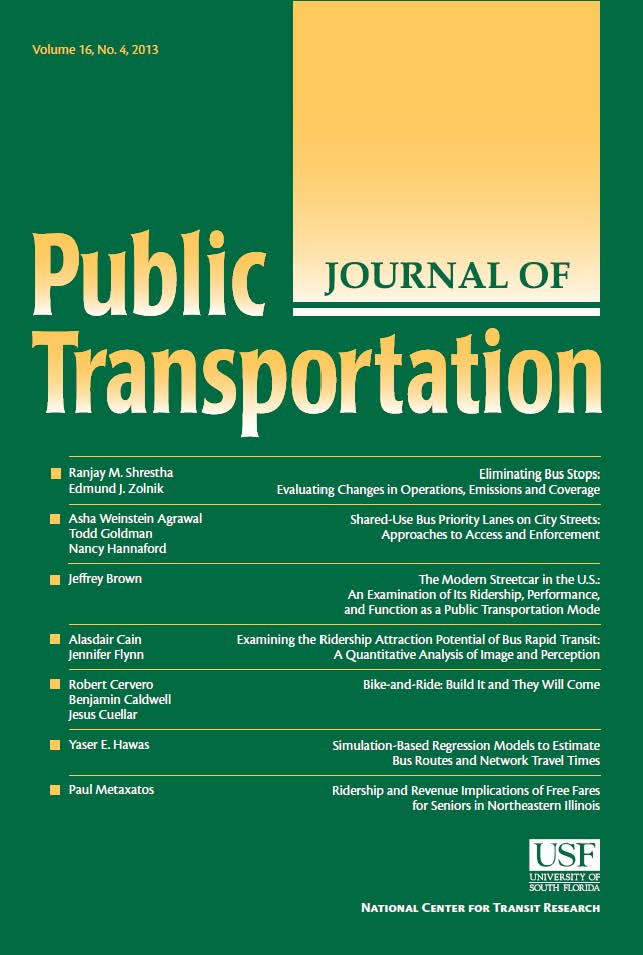Measuring the operational impacts of a new Bus Rapid Transit (BRT) in Montreal, Canada
IF 2
4区 工程技术
Q3 TRANSPORTATION
引用次数: 0
Abstract
Recent research on Bus Rapid Transit (BRT) systems has mostly focused on ridership forecasting and scheduled travel time gains, with little empirical evidence on potential operational improvements. This study examines the short-term impacts of implementing a new BRT corridor in Montreal, Canada, on key bus performance indicators: running time, running time deviation, and headway deviation. Using Automatic Vehicle Location (AVL) and Automated Passenger Count (APC) data from 2022 to 2023, we compare the performance of the BRT to a parallel local bus route operating along the same corridor, before and after the BRT implementation. Our findings indicate that the BRT significantly reduced trip durations (about four minutes on average) primarily due to infrastructure features such as dedicated lanes and all-door boarding policy. The local route experienced modest running time improvements post-BRT, suggesting potential corridor-wide benefits. However, run time deviation was significantly higher for the BRT, particularly during peak periods while headway deviation worsened along the corridor compared to pre-BRT conditions. These findings highlight the importance of integrating infrastructure investments with dynamic operational strategies such as real-time dispatching and headway control. It emphasizes the need for schedule calibration following implementation to ensure that planned service aligns with actual performance. These findings offer practical insights for transit agencies planning or managing BRT systems.
测量加拿大蒙特利尔新的快速公交系统(BRT)的运营影响
最近关于快速公交(BRT)系统的研究主要集中在乘客预测和计划旅行时间的增加上,很少有关于潜在运营改进的经验证据。本研究考察了在加拿大蒙特利尔实施新的快速公交走廊对关键公交性能指标的短期影响:运行时间、运行时间偏差和车头偏差。利用2022年至2023年的自动车辆定位(AVL)和自动乘客计数(APC)数据,我们将BRT的性能与沿同一走廊运行的平行本地公交路线进行了比较,前后BRT实施。我们的研究结果表明,BRT显著缩短了行程时间(平均约4分钟),这主要是由于基础设施的特点,如专用车道和全门登机政策。brt后,本地路线的运行时间略有改善,这表明整个走廊都有潜在的好处。然而,BRT的运行时间偏差明显更高,特别是在高峰时段,而与BRT之前的情况相比,走廊沿线的车头时距偏差更严重。这些发现强调了将基础设施投资与实时调度和车头距控制等动态运营策略相结合的重要性。它强调需要在实施之后进行计划校准,以确保计划的服务与实际性能保持一致。这些发现为规划或管理BRT系统的运输机构提供了实用的见解。
本文章由计算机程序翻译,如有差异,请以英文原文为准。
求助全文
约1分钟内获得全文
求助全文
来源期刊

Journal of Public Transportation
TRANSPORTATION-
CiteScore
6.40
自引率
0.00%
发文量
29
审稿时长
26 days
期刊介绍:
The Journal of Public Transportation, affiliated with the Center for Urban Transportation Research, is an international peer-reviewed open access journal focused on various forms of public transportation. It publishes original research from diverse academic disciplines, including engineering, economics, planning, and policy, emphasizing innovative solutions to transportation challenges. Content covers mobility services available to the general public, such as line-based services and shared fleets, offering insights beneficial to passengers, agencies, service providers, and communities.
 求助内容:
求助内容: 应助结果提醒方式:
应助结果提醒方式:


